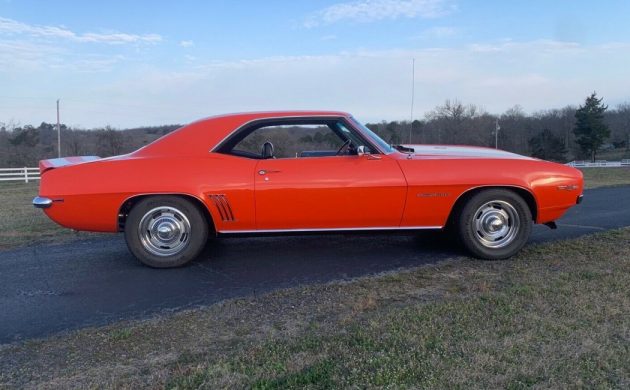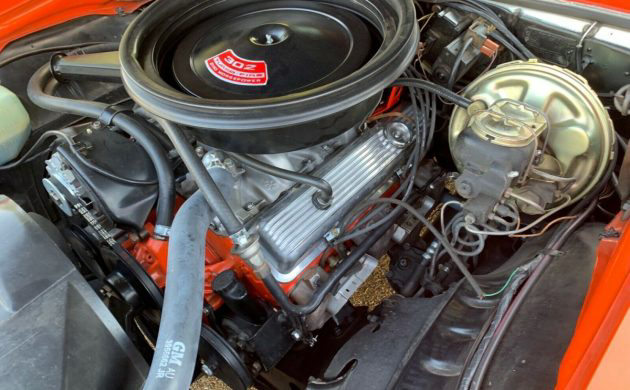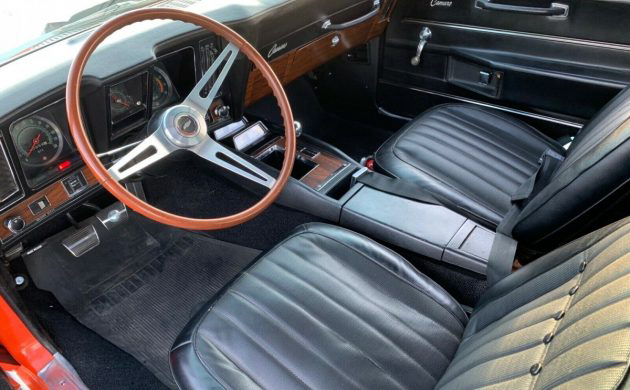When a classic car enthusiast passes away, the fate of their collection can be left up in the air. Some families choose to retain these vehicles as a fitting memorial to their loved one. In contrast, others will liquidate the collection to divide the estate fairly and equitably. The second scenario appears to be the case with this 1969 Chevrolet Camaro Z/28 RS. It presents exceptionally well and features the drivetrain combination that made the Z/28 a legend. The family has decided that it needs to head to a new home, so they have listed it for sale here on eBay. Located in Atkins, Arkansas, bidding has hit $56.600, although this remains short of the reserve.
I’m probably not the only person who feels that there is no color more iconic to grace the panels of a First Generation Camaro than Hugger Orange. It is a vibrant shade owing nothing to subtlety, but it achieves that feat without being tasteless or tacky. It is also one of those rare colors that manage to remain fresh and ageless after more than five decades. The seller indicates that while the shade is original to this car, the deceased owner treated it to a repaint in the 1990s. It retains an impressive shine, although the supplied photos reveal flaws, marks, and chips that are in keeping with paint of this age. None of the problems are severe, and if the buyer wished to leave the exterior untouched, it should cause no problems. While some buyers elected to delete the White stripes that were an integral part of the Z/28 package, this one wears its loudly and proudly. Their condition is as impressive as the paint, while there are no glaring issues with the trim or glass. The car features the standard RS package covered headlamps, and these appear in good condition. The panels are straight, with no significant marks or bruises and no visible rust. The underside shots paint a similar picture, although I believe that the deceased owner replaced the back floors at some point. The seller states that the firewall and cowl retain their original paint, and when you piece together all of the supplied photos, they suggest that the new owner will slide behind the wheel of a rust-free car.
It is said that motorsport improves the breed, and it is almost certain that the Z/28 would never have existed had the Trans Am Series not been at the height of its popularity in the late 1960s. Manufacturers subscribed to the “win on Sunday, sell on Monday” philosophy, with Ford’s Boss 302 Mustang and the Camaro Z/28 competing head-to-head in the 5.0-liter class. The maximum engine capacity was specified as 305ci, with both the Boss and the Z/28 squeaking under that figure at 302ci. The Z/28’s motor was a thinly-disguised race engine that produced a claimed 290hp and 290 ft/lbs of torque to propel the Camaro through the ¼ mile in 15.6 seconds. However, the truth may have been very different. The first thing to consider is that the ¼-mile figure is not indicative of the Z/28’s performance potential. With both maximum power and torque delivery sitting high in the engine’s rev range, the car could be relatively lethargic from a standing start. The other factor in play is the prevailing tendency by manufacturers to understate actual power outputs. While this can be by a small amount in some cases, many knowledgeable individuals feel that when it came to lies, Chevrolet told a whopper! General consensus in 1969 was that Z/28 drivers had significantly more than 300hp at their disposal, and some even suggested numbers beyond 400hp. There’s a bit to unpack with this Camaro. Starting at the front, it appears that the engine is original, although the deceased owner treated it to a rebuild. The transmission’s story is a little different. While it is a correct four-speed, it isn’t original. It features a Chevrolet Service Case rebuilt with the right parts and internal components. The 12-bolt Posi rear end is also overhauled, utilizing the correct 3.73 gears. Sadly, the seller supplies no information on how the Z/28 runs or drives, but the news should be positive if appearances count as an accurate indication.
Apart from a replacement dash pad installed by the deceased owner, the Camaro’s trim and upholstery are claimed to be original. It isn’t perfect, but it presents impressively for a car of this age. The seller reveals a couple of repairs to the seat upholstery, but these appear to be seam separations rather than rips or tears. The remaining trim looks excellent, as does the console and faux woodgrain. There are no aftermarket additions, which will help this classic’s potential value. The factory radio is intact, as are the distinctive console-mounted gauges. There are also a couple of other features worthy of note. Out of a total 1969 production of 243,085 Camaros, this is 1-of-7,912 ordered with a rear window defogger. Rarer still is the woodgrain sports wheel, with 6,683 buyers selecting that option. However, the tilt wheel wins the rarity war, with only 6,575 Camaros rolling off the line with that option.
The 1969 model year was a successful one for Chevrolet’s Camaro Z/28. With 20,302 cars rolling out showroom doors, that represented more sales than the previous two years combined. Today, the Z/28 remains as popular as ever. This car is yet to reach the reserve, and I believe there might need to be plenty more bidding action before that occurs. Recent sales results suggest that $70,000 would be a low-end estimate, although I wouldn’t be surprised if the bidding reaches $80,000. Even if those figures are too rich for your blood, this auction should still be worth watching.






Take factory spec cam,put in 283 ,60 over ,you got high rev machine
How do you not be a fan of these. High winding, 11.0:1, solid lifter goodness. They sound so good. Sure theres not much in the low end but thats how it goes with a destroked motor. High rpm capability with the power coming in late, vs the more common upstroke where you gain lots of low end torque. This is a great color combo, one of my two favorites but Fathom Green with white stripes and black interior edges it out for me. Set of headers and some chambered pipes and away we go!
Much better than the custom one from yesterday .
I’m always suspicious of ads that talk about numbers and originality, but never actually say the engine’s original, or numbers matching, or show the engine stamp pad. The seller talks about the trim tag, but never shows it either.
The ad says the “engine has been rebuilt and sports angle plug service heads”, the trans is a “service case……rebuilt with the correct gearset” and the rear was rebuilt and “the correct 3.73 gears” and “posi unit” were installed. This sounds to me like the original drive train may be long gone? The true heart of any 69 Z/28 is the DZ 302, and if you’re going to be looking for top dollar for a Z/28, you should include proof that it really is one.
I must admit that when I first saw this car I got a little excited. In 69 I was 15 car crazy kid, and my dream car was a Hugger Orange 69 Z/28, though I dreamed of one with the standard front end, black stripes and a black vinyl top. I was saving every penny I got, but by the time I got my license in 71 the Camaro was a completely different car. I liked the 71 Z/28, but not as much as the earlier ones, and I ended up with something completely different, an El Camino. I’m sorry I missed out on a 69 Z/28, but not that I bought the El Camino.
Nice choice on the Camino 👍
Did the 69 model have a 2 carb set up ? i thought these came with a taller gear than 3.73 to help top end and hi rpm driving. What a cool camaro these were
The cross ram setup was optional but not standard. Gearsets varied like anything else.
All Z/28’s left the factory with a single 800 CFM Holley carb.
In the 67 Trans Am, both the Mustang’s and Cougar’s were racing 289’s with 2×4’s. Chevrolet felt they needed a 2×4 set up to compete, so in late 67 they developed the Cross Ram 2×4 intake for the Z/28. A GM corporate edict banned the use of multiple carburetor’s on all GM vehicles except the Corvette after 1966, so the Z/28 Cross Ram was only available through the GM parts system. The Cross Ram wasn’t very streetable, and was really only intended for racing. The Z/28 lacked bottom end to start with, and since the Cross Ram didn’t really come alive till around 5000 RPM, it made the Z’s low end performance even worse.
The standard gear ratio with both the close and wide ratio 4 speeds in the Z/28 was the 3.73, with 3.55 and 4.11 available as regular options, and a 3.31 as a special order. A 3.07 could be special ordered with the wide ratio 4 speed. The Z/28’s 302 doesn’t really produce much power below 3000 RPM, so I can’t imagine driving one with a 3.31, let alone a 3.07.
Chevrolet rated the carburetor as 780 cfm.
I miss my 1969 Z so much, I would happily drive this one with the rear-end stuffed with banana peels, Marvel Mystery oil and a pound of Wildroot Hair cream.
At least the reverse (back up lights) and rear bumper guards look correct
If you really want to verify, Jerry Mcniesh would be your go to guy.
The second picture down, straight side shot of it, brought an “awe wow!” reaction in me and why the oldies will always be my favorite machines. Whether or not I’ll own one ever again doesn’t even matter. Class act all the way, screaming to the brink of self destruction and all that wonderful noise. The new performance cars can put it to shame but so what really, you either got class or you don’t! Great Camaro up there for sale and thanks for reminding me of how great cars Used to be. Really.
4:56 or 4:88s were better matches for a tuned 302. Neither was much fun on the Interstate though and sometimes resulted in an early (blueprinted) rebuild. 3:73s would have been too long for fun so maybe 4:10s were the best tradeoff.
I was never a fan for the Hugger Orange among the various colors my friends had back then (one was orange). Mine was Fathom Green/white with green interior and black vinyl top. Sorta understated for a Z. Nevertheless the orange is sorta the iconic color pick if you like it.
RS Garnet Red, black stripes, black and white houndstooth the ultimate 69 Z combo. Turned down one in 1985 near Philadelphia. Test drove it. He wanted $6,000. It had original rotted out chambered exhaust. It was not reproduced yet. I called a well known Corvette restorer friend of mine, who I eventually ended up working for. Asked him if he had any NOS chambered systems lying around. He said, “rare as hens teeth”. I passed on the car, because I could not live with myself for putting on standard exhaust system. Stupid I know. Wonder where that car is now.
My cousin had 2 ’69’s, the first still had its smog pump when I bought it around 1976 for $1600, it had under 50K miles, the second was Daytona Yellow with a black vinyl roof, had the console gauges, and was a very early production date so had some oddities like a Corvette steering box from the factory. He promptly blew the engine. Got a replacement DZ block and that was what he built up in that comment I left earlier, I think he was in and out of that car for under $3500.
Add an Edelbrock Victor Jr manifold, tweak the carb, a Mallory dual point distributor and uncapped headers, and put everything back together after a balance and blueprint and you are good up to 7000 RPM. That Mallory will give you a high rev power band pushing 475 HP.
The factory chambered exhaust was a gas…especially on a street car that had headers and low gears. Lakewood or similar traction bars looked sorta cool and helped the launch too ;-)